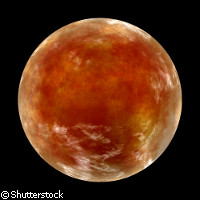New Martian meteorite study gives clues to planetary evolution
A new analysis of the Martian meteorite ALH84001 has revealed that this much-discussed sample of alien rock is 4.019 billion years old - 400 million years younger than earlier estimates. The findings of the Belgian-US research team, published in the journal Science, provide valuable insights into the nature of Mars' interior and will help scientists refine models of planet formation and evolution. The Allan Hills 84001 meteorite (ALH84001) is thought to be one of the oldest pieces of the Solar System. Scientists believe it may have been originally broken off the Martian surface by a meteorite impact, to be later blasted off in a bout of volcanic activity and hurled to the Earth. The ALH84001 meteorite is unique in that it predates other Martian meteorites by more than 2.5 billion years, making it the only sample of material here on Earth that was formed early in Mars' history. Previous examinations of ALH84001 have given it an age of around 4.5 billion years, and this has been a matter of some debate. According to the new study, establishing the correct age of the rock is central to our understanding of the formation history of the Martian crust and mantle, the timeline for the formation of its craters and the onset of its magnetic field (a magnetic field allows a planet to deflect solar wind and other highly charged particles; Mars lost most of its magnetic field more than 4 billion years ago). The team, led by Dr Tom Lapen of the University of Houston in the US and with the help of Dr Vinciane Debaille from the Université Libre de Bruxelles in Belgium, applied a relatively new method called lutetium-hafnium isotope analysis to samples of ALH84001, and were able to determine that the sample is younger than previously thought. Initial dating analysis was followed up with further tests that revealed valuable information about the planet's chemistry. 'We studied variations in isotopic compositions of minerals to determine the age and sources of magmas that produced these rocks,' Dr Lapen explained. 'We uncovered evidence that the volcanic systems in Mars were likely active more than 4 billion years. This connection allows the possibility that regions with the largest volcanoes in the Solar System perhaps host some of the longest-lived volcanic systems in the Solar System.' The younger age indicates that the primordial Martian crust was likely to have been destroyed by intense bombardment 4.25 to 4.1 billion years ago, the study concludes. The results indicate that ALH84001formed when Mars was wet and had a magnetic field - conditions that are favourable to the development of simple life forms. Based on the findings, the meteorite is not actually a remnant of primordial Martian crust; indeed, they confirm that volcanic activity was ongoing on Mars over much of its history. 'This research helps us better refine the history of Mars,' study leader Dr Lapen pointed out. 'This has huge ramifications for our understanding of volcanic processes active in Mars and for the nature of deeper portions of the planet that are sources of magmas that produced the largest volcanoes in the Solar System. These data also are used to refine models of initial planetary formation and early evolution.'
Countries
Belgium, United States



